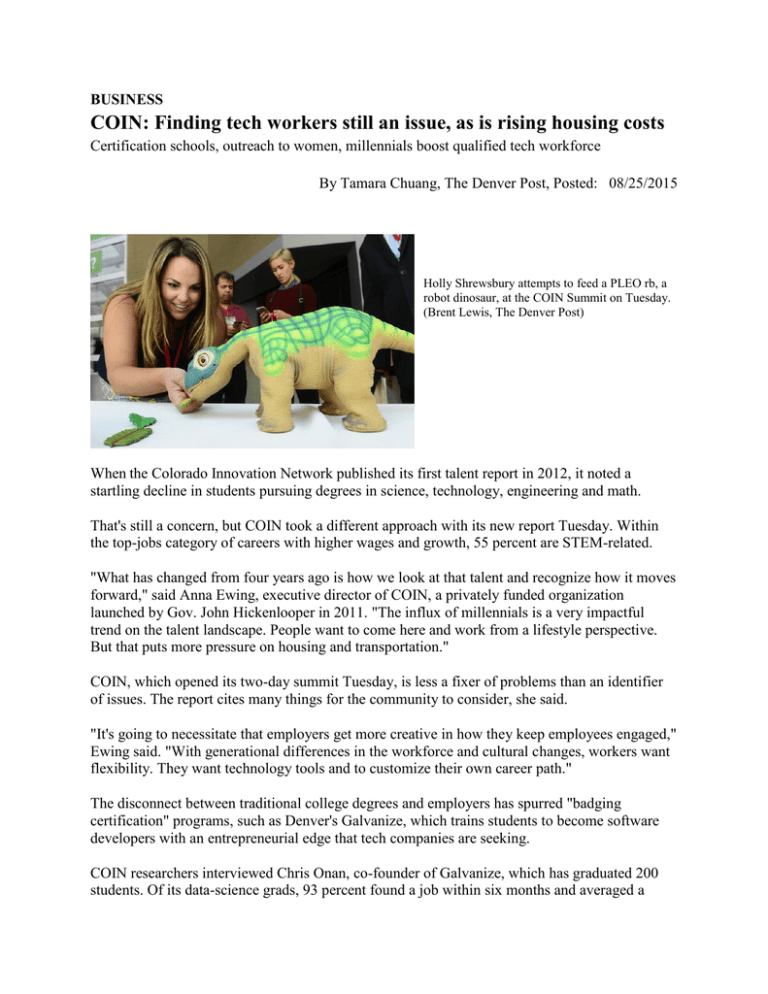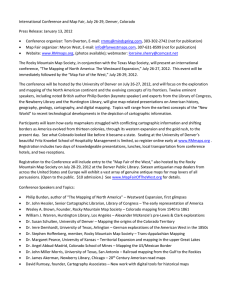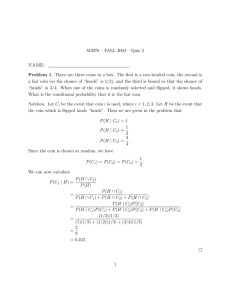COIN: Finding tech workers still an issue, as is rising...
advertisement

BUSINESS COIN: Finding tech workers still an issue, as is rising housing costs Certification schools, outreach to women, millennials boost qualified tech workforce By Tamara Chuang, The Denver Post, Posted: 08/25/2015 Holly Shrewsbury attempts to feed a PLEO rb, a robot dinosaur, at the COIN Summit on Tuesday. (Brent Lewis, The Denver Post) When the Colorado Innovation Network published its first talent report in 2012, it noted a startling decline in students pursuing degrees in science, technology, engineering and math. That's still a concern, but COIN took a different approach with its new report Tuesday. Within the top-jobs category of careers with higher wages and growth, 55 percent are STEM-related. "What has changed from four years ago is how we look at that talent and recognize how it moves forward," said Anna Ewing, executive director of COIN, a privately funded organization launched by Gov. John Hickenlooper in 2011. "The influx of millennials is a very impactful trend on the talent landscape. People want to come here and work from a lifestyle perspective. But that puts more pressure on housing and transportation." COIN, which opened its two-day summit Tuesday, is less a fixer of problems than an identifier of issues. The report cites many things for the community to consider, she said. "It's going to necessitate that employers get more creative in how they keep employees engaged," Ewing said. "With generational differences in the workforce and cultural changes, workers want flexibility. They want technology tools and to customize their own career path." The disconnect between traditional college degrees and employers has spurred "badging certification" programs, such as Denver's Galvanize, which trains students to become software developers with an entrepreneurial edge that tech companies are seeking. COIN researchers interviewed Chris Onan, co-founder of Galvanize, which has graduated 200 students. Of its data-science grads, 93 percent found a job within six months and averaged a $115,000 starting salary. Full-stack grads started at $73,000, and 98 percent found jobs within six months. The company has made efforts to reach women, veterans and minorities. It expects 500 students to go through its program this year, but that's not enough to meet demand, said Mark Saldaña, Galvanize's marketing manager. "Galvanize is going to have to scale (up) to meet employer demand for talent and student demand for technical skills in the coming years," he said. "We're partnering with organizations like IBM and (President Barack) Obama's TechHire initiative to fill the skills gap." Molly Rauzi uses a Google Cardboard to take a virtual flight to Chicago during the COIN Summit at the Denver Center for the Performing Arts. (Brent Lewis, The Denver Post) Stephan Weiler, a Colorado State University economics professor, worked on earlier COIN reports but not this year's. He said women will be taking on more roles because more women are going to college. "The real reason you need to be worried is ... the young people," he said, pointing to a chart showing that bachelor's degrees among young men are in decline — 34 percent for people ages 18-44, compared with 41 percent for those over 65. Colorado women, however, are getting more degrees — 42 percent of those under 45 have a bachelor's, compared with 25 percent of women over 65. The COIN report notes that women make up 48 percent of the state's workforce but only 23 percent of STEM jobs. "There are more women going to college, and they are underrepresented in STEM," Weiler said. Another COIN concern is the high cost of housing in the Denver and Boulder areas. Transportation issues and pricey child care are also mentioned in the report. Denver rents and home-sale prices have been increasing faster than the U.S. average. That is a concern for luring workers. COIN reports that many are moving to the area only if they have a job first. Katie Essman, regional president for Robert Half, a staffing agency, said Colorado's appeal still outweighs housing costs. "We're not hearing millennials specifically say, 'I don't want to move to Denver because the cost of living is too high.' They're moving here but making compromises like getting roommates," Essman said. "People are not necessarily attracted to Denver because it's less expensive but because it's a better way of life." Tamara Chuang: 303-954-1209, tchuang@denverpost.com or twitter.com/Gadgetress COIN numbers 5: Colorado's rank for net new residents moving to the state 2: Colorado's rank for number of residents with bachelor's degree or higher 49: Colorado's rank in higher-education state funding per student 32.3: Percentage change between 2008 to 2013 that state government cut spending per student 40.8: Percentage change between 2008 to 2013 that tuition increased at state schools $24,520: Average student debt on graduating from state university with four-year degree 22.4 percent: Denver and Colorado Springs workers who are in STEM jobs (chemistry, computer science, engineering, environmental science, geosciences, life sciences, mathematics and physics/astronomy). 33 percent: Portion of the U.S. workforce who are millennials (or 53.5 million), making it the largest share of all workers, as of January, according to Pew Research. Nao, a robot developed at the University of Denver, kicks a ball during the COIN Summit at the Denver Center for the Performing Arts on Tuesday. The COIN Summit is a forum to develop ideas for change in the way people live and how businesses work. (Brent Lewis,The Denver Post)







